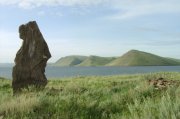 At the 12th Congress of the Khakass nation, which took place on 18 March, the participants confirmed a list of sacral locations in Khakassia. Director of Khakass scientific research institute of language, literature and history, Doctor of historical studies Valentina Tuguzhekova explained to the correspondent of "Abakan" why such a list is necessary and which objects are included on the list.
At the 12th Congress of the Khakass nation, which took place on 18 March, the participants confirmed a list of sacral locations in Khakassia. Director of Khakass scientific research institute of language, literature and history, Doctor of historical studies Valentina Tuguzhekova explained to the correspondent of "Abakan" why such a list is necessary and which objects are included on the list.
The creation of such a list is necessitated by socio-economic changes of the past several years. Today it is possible for private entities to rent huge territories (taiga, fields, etc.), where objects sacred to the Khakass people may be located. And it is necessary to do everything possible for these places to remain accessible for performance of ritual practices. At this congress, we have confirmed this list of 96 sacral locations of the Khakass nation, and we will submit it to the Supreme Council of the republic. We hope that in the future, under the law about historical-cultural heritage, the sacral places of Khakass people will be taken under the protection of the government.
What can be considered a sacral location?
The meaning of the word "sacral" (from Latin "sacer" - holy) - means cultic, ritual, secret. The sacral monuments of Khakassia are a part of ethnic culture of the Khakass.
Sacral, or sacred place is a place which has a holy status; it is a location, a spatial object, which is excluded from the realm of daily life and reserved for carrying out regular cultic activities, intended for interaction with sacred entities and powers. It is distinguished from worldly or religious spatial objects by a complex of ideal (spiritual) and material (physical) characteristics. On the ideal plane, in religious consciousness, a sacred place is of the highest value, the earthly abode of spirits and deities, a point of concentration of magic powers, which brings about a feeling of veneration and awe, and which demands the utmost in respectful attitude. The evidence of such characteristics in historical documents or ethnographic data allows the identification of a spatial location as a shrine, a holy place.
Concrete studies of ancient sacred places shows, that in the majority of cases the locations for establishing them were not at all chosen at random. People distinguished places in their earthly environment which called up strong emotional reactions, awakened imagination and stimulated intellectual activity; these spatial loci corresponded to religious ideas of habitation of spirits, deities and other "powers", marked by a quality of holiness.
In the early stages of history, objects of natural landscape (mountains, water springs, etc.) were strictly assigned by families or clans. As a result, "clan territories" appeared, which had clear natural boundaries. In assimilation of a territory, an object of landscape was the most significant feature (a valley, a mountain, a lake, etc.) that is - the place where people gathered to carry out group activities. That is how clan or family territories of worship formed.
For peoples of South Siberia, natural places where national holidays, cultic rituals, and shamanic kamlanie took place were considered sacral, that is holy places. As a rule holy places were associated with the traditional world view of the indigenous people of South Siberia. Just like in earlier times, the majority of the indigenous peoples of South Siberia (Khakass, Tuvan, Altai and Shor people) deify nature, natural elements and phenomena; worship of various natural elements and spirits: spirit of fire, spirit of water, spirit of mountains, etc is preserved in folk memory and in ritual practices.
What is included in the list
 In Khakassia, just like in other regions of South Siberia it is not only sacred mountains and certain localities that are considered sacred, but archeological monuments are in this category as well: ancient kurgans, stone statues and others. According to the calculations of ethnographer Viktor Butanayev, there are about 200 cultic places in Khakassia; according to the Council of the Elders of Republic Khakassia, there are more than 300.
In Khakassia, just like in other regions of South Siberia it is not only sacred mountains and certain localities that are considered sacred, but archeological monuments are in this category as well: ancient kurgans, stone statues and others. According to the calculations of ethnographer Viktor Butanayev, there are about 200 cultic places in Khakassia; according to the Council of the Elders of Republic Khakassia, there are more than 300.
Mountains are the most venerated objects among the Khakass population: Borus, Izykhskie, Uitag, Samokhval, Sunduki. The mountains formed the Khakass ideas about their territory as about a mountain-steppe country, located in the center of the Sayan-Altai mountains and surrounded on all sides by mountain ridges. For example, Kuznetskiy Alatau, in the poetic language of Khakass folklore, is called "Ulgennig syn" ( Divine Ridge) and the Sayans - "Khan Tigir syn" (Celestial Ridge).
The great mountain heights of Khan-Purgus (Borus), Khan-Pradai, Kol-Taiga, Khan-Chalban and others represent clan mountains, from where all the Khakass seoks (clans, literally "bone") derive their sources. To worship the mountain spirits, shamans held kamlanie every three years. These venerated mountains and localities , which had their protector-spirits, were called "eelig chir", literally "land which has a master". Usually anomalous phenomena occurred there, associated with activities of mountain spirits. The Khakass have a respectful attitude to such places, and when they pass by, they always perform libations with wine or sprinkle tobacco.
On mountain passes, sacred structures of piled-up stones , "obaa", were built. Every passer-by was obligated to bow to them and bring in his contribution. As a rule, men would leave stones which they took along with them before the ascent, and women would push birch branches into the stone pile on the east side. If it was the first time a person has come to a particular mountain pass, he definitely had to tie a sacred ribbon "chalama" on the wood poles stuck in the piled-up stones of the "obaa", otherwise the duration of his life would be shortened. It was not permissible to laugh or sing songs around the obaa. if they had wine, those present would circumambulate the sacred stone pile three times clock-wise, and would sprinkle the alcohol on the obaa. It was prohibited to ascend mountain passes at nighttime.
Beside sacred mountains and mountain passes, the Khakass have also revered the cult of water since ancient times. Every year at the beginning of summer during the new moon, they performed prayers to the water (sug tayii) at the sources of venerated streams or on the banks of large rivers Abakan, White and Black Iyus, Chulym and Yenisei. In the lake country of northern Khakassia, water sacrifices used to be performed on the lake shores. Prayers were performed on the shores of lakes such as Khaara-kol, (Black lake,), Oc-kol (Aspen Lake), Airan-kol (Airan Lake), Tigir-kol (Celestial Lake), and others.
In the valleys of rivers Abakan, the Iyuses, Chulym and Yenisei, the Khakass people performed Celestial prayers every year. In Khakassia, more than a hundred mountains were identified, where prayers to the Great Heaven were performed on the peaks, and 20 of them have names "Tigir taiychan tag" - Mountain of Heavenly sacrifices. In some places, like, for example, in the valleys of rivers Ulen, Kamyshta and Ninya, the celestial prayers were held at a different mountain every year, but would return to the starting point after three years. For example, the Kirbizhekov family held "Tigir tayii in the first year on Mt. Bytag, then on Mt. Khaibytag, the third summer on Mt. Khuyulyg-tag, then everything was repeated again. People of the Ust-Byur aal had sacrifices to Heaven on Mt. Kolergit the first year, second year on Mt. Chan-ssorakh, and the third year on Mt. Izykh-tag at the upper reaches of river Uibat, then again on Mt. Kolergit.
The Kachins of Abakan (aal Troyakov and others) used to hold prayers to Heaven on Mt. Saksor, on the right bank of river Uibat (a tributary of Abakan), and people of various seoks would gather there.
Beside veneration of holy mountains, water and heaven, the Khakass people also worshipped places of burial (cult of ancestor worship), heavenly bodies, sacred menhirs, clan localities, and ancient shrines. Among the most venerated stone statues, Akh-tas (white stone) must be mentioned, and Ulug Khurtuyakh-tas (Large stone old woman). One kilometer north-east from Kazanovka village, on the left bank of river Askiz, there towered a picturesque cliff Iney-tas (Stone old woman) until the 1960's. That place has another two names: Iney-khaya(Old woman rock), and Iney-pary (foot of Iney). This monument had a double significance: it was the family mountain of the Mainagashevs and the protector of herding for the entire local population.
This is by no means a complete list of holy, sacral locations in Khakassia, which have been venerated since old times, and are venerated by contemporary Khakass population, where traditionally shamans perform rituals of sacrifice and of worship of spirits and of ancestors. As we have already noted, the Congress confirmed only 96 sacral places of the Khakass people.

